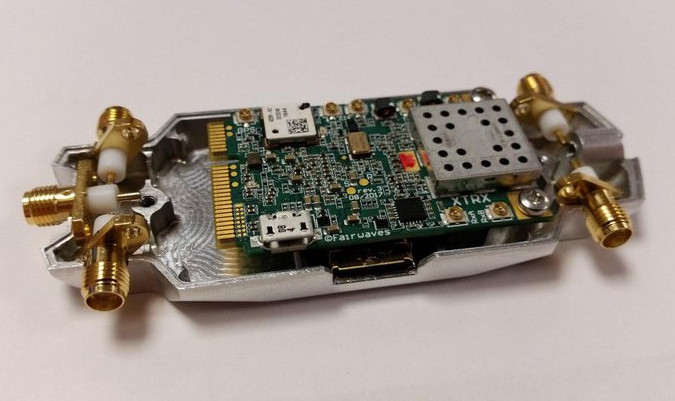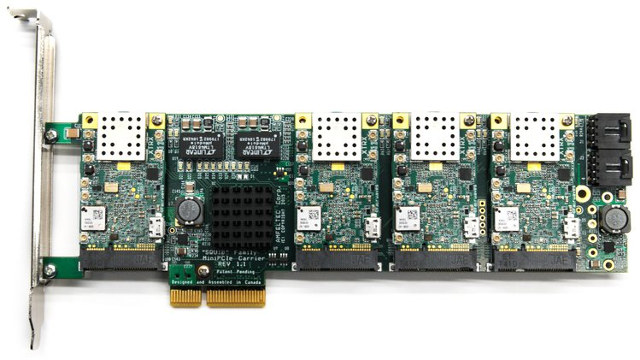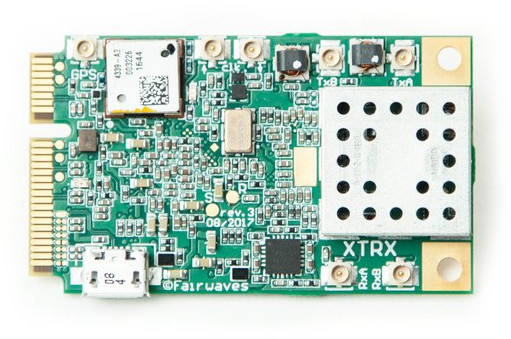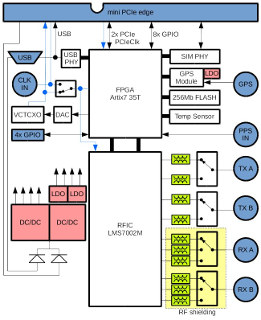Fairwaves is a startup that aims to make deploying and operating mobile networks in rural regions profitable, and their latest project is called XTRX, a high performance Software Defined Radio (SDR) board packed into a mini PCIe card form factor.
The project was launched on Crowdsupply earlier with year, got fully funded by around 700 backers, and the company is now working on fulfilling backers rewards by the end of August.
- RF Chipset – Lime Microsystems LMS7002M FPRF (as found in LimeSDR Mini)
- FPGA Chipset – Xilinx Artix 7 35T
- RF

Block Diagram – Click to Enlarge - Channels – 2 × 2 MIMO
- Sample Rate – ~0.2 MSPS to 120 MSPS SISO / 90 MSPS MIMO
- Tuning Range: 30 MHz – 3.8 GHz
- Rx/Tx Range:
- 10 MHz – 3.7 GHz
- 100 kHz – 3.8 GHz with signal level degradation
- PCIe
- Bandwidth
- PCIe x2 Gen 2.0 up to 8 Gbit/s
- PCIe x1 Gen 2.0 up to 4 Gbit/s
- PCIe x1 Gen 1.0 up to : 2 Gbit/s
- Bus Latency: <10 µs, stable over time
- Bandwidth
- Reference Clock -26 MHz; Stability: <10 ppb stability after GPS/GNSS lock, 500 ppb at start up
- GPIO Expansion
- FPC Edge Connector – 4x lines (usable as two diff-pairs)
- Mini PCIe Reserved Pins: 8x lines (including two diff-pairs, 1pps input, 1pps output, TDD switch control, and three LEDs)
- Dimensions – 30x51mm (full-size Mini PCIe)
Some accessories are also available for the board including antennas & cables, a USB 3 adapter with aluminum enclosure, a PCIe x2 + front-end adapter, and a PCIe octopack, which enables synchronization of multiple XTRX boards (up to 8) for “massive MIMO” deployment.

Documentation, and source code can be found in xtrx-sdr Github account, where you’ll find connector pinout, 3D models, pre-built binaries, a getting started guide, and modified open source applications such as SDRangel, osmo-trx,Kalibrate, and gr-osmosdr.
Potential applications for the platform include bandwidth monitoring (up to 1 GHz of bandwidth with 8 XTRX cards), software defined 2G/3G/4G/LTE cellular modems, DSP acceleration, and various use cases for drones and embedded systems.

The crowdfunding campaign is over, but Crowdsupply allows for pre-orders afterwards, so you can now pre-order a XTRX revision 4 board for $260 without any accessories. Other rewards include the $515 XTRX Deluxe Bundle with the mini PCIe card, cables, USB 3.0 enclosure and PCIe x2 + front-end adapter, or the complete 8 boards Octopack for $2,900.

Jean-Luc started CNX Software in 2010 as a part-time endeavor, before quitting his job as a software engineering manager, and starting to write daily news, and reviews full time later in 2011.
Support CNX Software! Donate via cryptocurrencies, become a Patron on Patreon, or purchase goods on Amazon or Aliexpress






